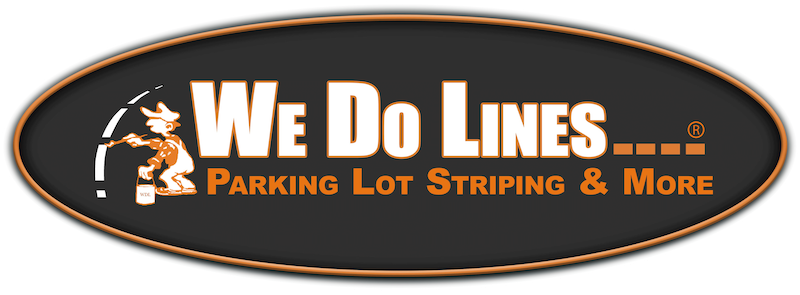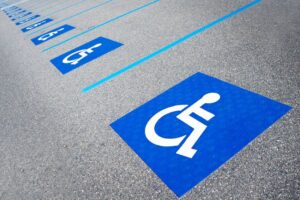The Americans with Disabilities Act (ADA), enacted in 1990, marked a significant milestone in the fight for civil rights, prohibiting discrimination based on disability. It brought a new focus on accessibility in public spaces, ensuring that everyone, regardless of ability, has access to community facilities and services. Among its many provisions, the ADA sets forth guidelines that address the construction and layout of parking lots, making them accessible to people with disabilities. This guide delves into the specifics of these regulations, particularly the striping of handicapped parking spaces, which is a crucial aspect of compliance. Through this article, business owners and property managers will gain a thorough understanding of their legal obligations and receive practical advice on how to implement these requirements effectively.
Understanding ADA Requirements for Handicapped Parking
ADA compliance is vital in the layout and design of any public or commercial parking facility. Here are the key elements required for handicapped parking:
- Number of Accessible Parking Spots: The ADA provides a clear formula for determining the minimum number of accessible parking spaces based on the total number of parking spaces in the lot. For example:
- 1 to 25 total spaces: at least 1 accessible space.
- 26 to 50 total spaces: at least 2 accessible spaces.
- 51 to 75 total spaces: at least 3 accessible spaces.
- 76 to 100 total spaces: at least 4 accessible spaces.
This scale continues to increase as the total number of parking spaces increases, ensuring proportional accessibility as facilities expand.

- Dimensions and Placement: Accessible parking spaces must be specifically sized and located to meet the needs of those who use them. Standard spaces are 96 inches wide, while van-accessible spaces require a 96-inch wide access aisle alongside the space. These spaces should be on the shortest possible route to the building entrance, and in cases where buildings have multiple accessible entrances, parking spaces should be dispersed to facilitate access to all entrances.
- Required Features of Handicapped Parking Spaces: Signage: Each accessible parking space must be marked with the International Symbol of Accessibility. Signage for van-accessible spaces must also reflect their specific designation. These signs should be mounted at a height visible from the driver’s seat of the vehicle, even when the parking space is occupied. Access Aisle Dimensions and Markings: Access aisles, the space adjacent to accessible parking spots, allow room for wheelchair users to maneuver. These must be marked clearly to discourage parking in them. Vertical Clearance: For van-accessible spaces, the vertical clearance must be sufficient to accommodate higher vehicles typically used by wheelchair users. This clearance must be maintained throughout the parking facility, including the vehicular route leading to the spaces.
Planning Your Parking Lot Layout
To achieve ADA compliance in a parking lot, meticulous planning is essential. Below are steps to guide you in organizing a compliant parking area:
- Assess Current Layouts for Compliance: Begin by reviewing your existing parking facilities against ADA standards. This assessment can help identify areas that fail to meet accessibility requirements and provide a foundation for necessary adjustments.
- Consulting with Experts: When planning a new parking lot or reconfiguring an existing one, consulting with ADA compliance experts or certified planners can provide essential guidance tailored to your specific needs.
- Incorporating Accessible Spaces: Based on the total number of parking spots, calculate the number of accessible spaces needed, ensuring you include both standard and van-accessible spaces. These should be situated as close as possible to the entrance and along routes that are least obstructive to pedestrian and vehicular traffic.
- Strategic Placement Near Entrances: Accessible parking spaces should be located on the shortest accessible path to the facility’s entrance. In cases where multiple accessible entrances exist, the spaces should be distributed to allow for easy access to all.
- Future Proofing: It is also wise to consider potential future needs as your property grows or as laws and standards evolve. Planning with foresight can save significant time and expense by avoiding the need for future modifications.
Practical Steps for Striping Handicapped Parking Spaces

Achieving ADA compliance in parking lot striping involves careful planning and execution. Here’s a detailed guide on how to approach this task:
Selection of Appropriate Materials and Paints
The longevity and visibility of parking lot markings depend significantly on the quality of materials used. For handicapped spaces, especially, it is crucial to use high-quality, weather-resistant paint that offers excellent visibility in all conditions. Reflective paints are particularly beneficial for ensuring the spaces are easily visible at night or in poor weather. Moreover, the use of durable thermoplastic markings can be considered for high-traffic areas as they are more resistant to wear and tear and provide a longer-lasting solution.
Preparation of the Surface
Before any painting begins, the surface must be properly prepared to ensure the best possible adherence of the paint:
- Cleaning: The surface should be thoroughly cleaned to remove dirt, oil, and debris. Power washing and professional surface cleaning treatments can be employed to achieve this.
- Repairs: Any potholes or cracks should be repaired. A smooth surface ensures that the paint goes on evenly and lasts longer.
- Drying: Ensure the parking lot is completely dry before applying any paint, as moisture can prevent proper adhesion and lead to premature wear.
Measurements and Marking for Standard and Van-Accessible Spots
Accurate measurements are crucial to comply with ADA standards:
- Layout: Use professional measuring tools to outline the space accurately, including the access aisle required for van-accessible spots.
- Marking: Temporary markings should be made with chalk or similar washable materials before any permanent paint is applied. This step ensures that any errors can be corrected easily.
Painting Techniques That Ensure Clear and Long-Lasting Lines
The application of paint must be done meticulously to ensure clarity and durability:
- Equipment: Use professional-grade striping machines that allow for uniform paint application.
- Technique: Apply at least two coats of paint, letting each dry thoroughly between applications to build a robust and wear-resistant marking.
- Inspection: After the paint has dried, inspect the markings to ensure they are clear and meet all required dimensions and visibility standards.
Legal and Safety Considerations
Understanding and adhering to regulations is essential for both local and federal for legal compliance and maintaining safety standards.
Understanding Local and Federal Regulations Beyond ADA Guidelines
While the ADA provides the federal baseline, local regulations can impose additional requirements. Business owners should ensure they are aware of and comply with both sets of guidelines to avoid legal complications. Consulting with an ADA expert or attorney can provide clarity and direction in navigating these complexities.
Importance of Regular Maintenance to Remain Compliant

Regular maintenance is key to ensuring that accessibility features remain functional and compliant:
- Regular Inspections: Schedule regular inspections to check for faded paint, debris blocking access aisles, or other issues that could impede accessibility.
- Touch-Ups: Quick touch-ups can address wear before it becomes a significant problem, maintaining the visibility and integrity of markings.
- Comprehensive Maintenance: Periodically, more extensive maintenance may be needed, such as resealing the asphalt or repainting entire sections of the lot.
Consequences of Non-Compliance
Non-compliance can have severe consequences, not only legally but also in terms of business reputation:
- Legal Penalties: Fines and penalties for non-compliance can be substantial, and in some cases, ongoing legal fees from lawsuits can accrue if the non-compliance leads to discrimination claims.
- Reputation: Businesses found non-compliant may suffer damage to their reputation, potentially leading to a decrease in customer trust and patronage.
Resources and Assistance
Navigating ADA compliance can be complex, but numerous resources are available to assist business owners and property managers:
- ADA National Network: Provides information, guidance, and training on the ADA. It is a valuable resource for detailed advice and support on compliance issues.
- Local Government Offices: Many local government offices have ADA coordinators or offices dedicated to helping businesses understand and implement ADA standards.
- ADA Compliance Experts: Consultants and experts specializing in ADA compliance can offer tailored advice and help in assessing and upgrading facilities.
- Grants and Financial Assistance Programs: Various programs are available to help small businesses finance modifications required for ADA compliance. These might include low-interest loans, tax incentives, or even grants.
Call to Action
As regulations and standards evolve, it is crucial for businesses to remain proactive in assessing and updating their facilities. Business owners and property managers are encouraged to:
- Review Current Parking Setups: Regularly evaluate whether your parking meets current ADA standards.
- Consult ADA Compliance Experts: Schedule consultations with experts to ensure that all aspects of your parking lot meet or exceed regulatory requirements.
- Engage in Ongoing Education: Stay informed about changes in ADA regulations and best practices in accessible design.
By taking these steps, businesses not only comply with the law but also move towards broader goals of accessibility and inclusivity, ensuring that their facilities are welcoming to everyone.
The commitment to ADA compliance in parking lot design is not merely about adhering to regulations but about contributing positively to the community and enhancing the operational ethos of inclusivity. By implementing compliant parking solutions, businesses demonstrate their respect for the dignity and rights of all individuals, which in turn can enhance their reputation and customer base. It is essential for business owners to recognize the broader impact of these measures, which extend beyond compliance to shaping a more accessible and equitable society.




